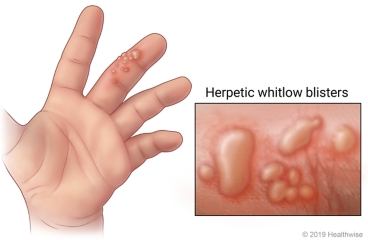Overview

Herpetic whitlow is a finger infection. It's usually caused by the herpes virus that causes cold sores. It can spread to a finger from a cold sore in or around your child's mouth.
An area of your child's finger may be red and swollen. It may have a small group of blisters. They are clear at first, then turn yellow. Over a few weeks, the blisters break open, crust over, and then heal. Your child's finger may hurt, itch, or tingle.
The finger should get better on its own. But whitlow may come back to the same area of the finger.
The doctor may prescribe medicines to help fight the herpes virus. Covering your child's finger with a bandage can help to avoid spreading the infection.
Follow-up care is a key part of your child's treatment and safety. Be sure to make and go to all appointments, and contact your doctor if your child is having problems. It's also a good idea to know your child's test results and keep a list of the medicines your child takes.
- Be safe with medicines. Give your child the medicines exactly as prescribed. Call your doctor if you think your child is having a problem with a medicine.
- Give your child acetaminophen (Tylenol) or ibuprofen (Advil, Motrin) for pain. Read and follow all instructions on the label. Do not give aspirin to children and teens. It has been linked to Reye syndrome, a rare but serious illness.
- If your doctor told you how to care for your child's finger, follow your doctor's instructions. If you did not get instructions, follow this general advice:
- Wash the area with clean water 2 times a day. Don't use hydrogen peroxide or alcohol. They can slow healing.
- You may cover the area with a thin layer of petroleum jelly, such as Vaseline, and a nonstick bandage.
- Wet a cloth with cool water, and apply it to the finger. This can help with pain and itching.
When should you call for help?
Contact your doctor now or seek immediate medical care if:
- Your child has symptoms that the infection is getting worse, such as:
- Increased pain, swelling, warmth, or redness.
- Red streaks leading from the area.
- Pus draining from the area.
- A fever.
Watch closely for changes in your child's health, and be sure to contact your doctor if:
- Your child does not get better as expected.
Current as of: September 30, 2025
Author: Ignite Healthwise, LLC Staff
Clinical Review Board
All Ignite Healthwise, LLC education is reviewed by a team that includes physicians, nurses, advanced practitioners, registered dieticians, and other healthcare professionals.

